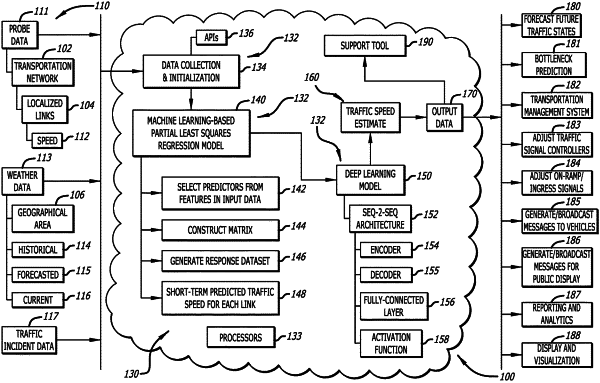| CPC G08G 1/0133 (2013.01) [G01W 1/10 (2013.01); G01W 1/14 (2013.01); G06N 3/04 (2013.01); G08G 1/0112 (2013.01); G08G 1/0129 (2013.01); G08G 1/0145 (2013.01); G08G 1/052 (2013.01)] | 45 Claims |

|
1. A method of characterizing traffic congestion in a transportation network, comprising:
receiving, as input data, probe data that includes localized, historical link-based speed information in a transportation network, and incident data that includes roadway maintenance activity within the transportation network;
analyzing the input data in a plurality of data processing elements within a computing environment that includes one or more processors and at least one computer-readable non-transitory storage medium having program instructions stored therein which, when executed by the one or more processors, cause the one or more processors to execute the plurality of data processing elements to characterize spatio-temporal dependencies in traffic speed, by:
selecting one or more predictors from features in the input data relevant to each link in the transportation network,
constructing a matrix defined by a number of time steps, and a plurality of features representing temporal characteristics in the one or more predictors selected for each link,
generating a multi-variate time-series dataset representing a predicted short-term traffic speed for each link from the matrix,
transforming differential time sequences in the multi-variate time-series dataset in a multi-layered neural network having a sequence-to-sequence architecture comprised of an encoder generating a hidden neural network state representing the multivariate time-series dataset, a decoder generating an output sequence, and a fully-connected layer that generates an estimate of traffic speed at one or more specific locations of the transportation network at one or more specified times where either a work zone is conducted or where a maintenance vehicle is operating; and
predicting traffic bottlenecks where either the work zone is conducted or where the maintenance vehicle is operating at the one or more specified times from the estimate of the traffic speed relative to the maintenance activity,
wherein one or more of: an operation of the maintenance is autonomously controlled, a route of the maintenance vehicle is remotely updated and performed, or a recommended route is updated for routing of roadway vehicles in or near the work zone, from the estimate of the traffic speed.
|